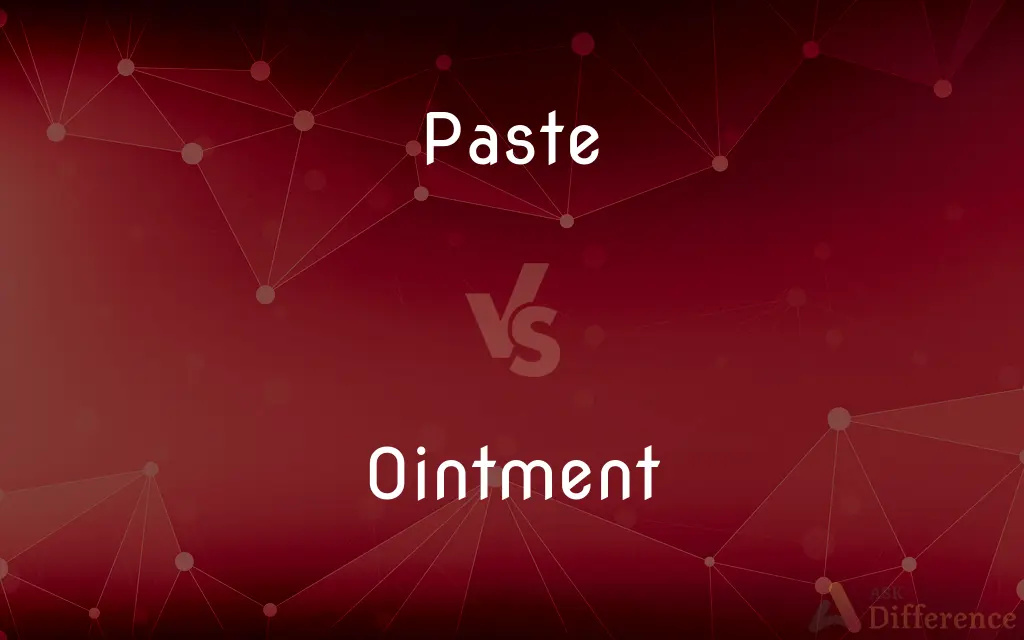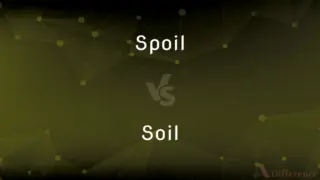Paste vs. Ointment — What's the Difference?
By Urooj Arif & Maham Liaqat — Updated on April 17, 2024
Paste is a thick, non-greasy medicinal preparation that adheres to the skin, providing a protective barrier; ointment, however, is a greasy, oil-based substance used for its moisturizing and healing properties.

Difference Between Paste and Ointment
Table of Contents
ADVERTISEMENT
Key Differences
Paste is typically composed of powders mixed with water or oil to form a thick substance that stays on the skin’s surface, making it ideal for protective purposes. Whereas ointments are oil-based and have a higher oil content, which helps in moisturizing and creating a barrier that promotes the skin’s healing process.
Pastes are generally good for drying out the skin, making them suitable for conditions like eczema or rashes where moisture reduction is beneficial. On the other hand, ointments are better for treating dry or scaly skin, as their oily nature helps add moisture and soothe the skin.
The consistency of paste is stiffer and it doesn’t melt easily upon application, which allows it to form a protective layer over the skin that can absorb moisture. In contrast, ointments are softer and tend to melt when they come into contact with the skin, spreading easily over larger areas.
When it comes to application, pastes are more likely to leave a visible residue on the skin, which can be important for barrier protection. Ointments, however, are clear and leave a shiny layer, which can be cosmetically less desirable for daytime use.
Ointments, due to their occlusive nature, are often used in nighttime skincare routines or in treating chronic dryness, because they effectively trap moisture against the skin. Pastes, with their absorptive properties, are often used in medical settings to protect wounds or irritated skin during healing.
ADVERTISEMENT
Comparison Chart
Base
Water or oil with powder
Oil-rich
Consistency
Thick and stiff
Soft and greasy
Moisture
Absorbs moisture
Adds moisture
Application
Leaves residue
Clear, shiny layer
Best used for
Drying out moist skin conditions
Moisturizing dry or scaly skin
Compare with Definitions
Paste
A semi-solid preparation usually used for medical or cosmetic purposes.
Apply the zinc oxide paste to the rash to relieve irritation.
Ointment
An oil-based substance used for treating, soothing, and moisturizing the skin.
Apply the ointment nightly to heal your dry skin.
Paste
A thick mixture that adheres well to surfaces without dripping.
Use the paste to cover the affected area completely.
Ointment
Typically clear and greasy when applied.
The ointment will leave a shiny layer on your skin.
Paste
Used primarily for protective barrier purposes.
The paste forms a protective layer over the wound.
Ointment
Used to create a barrier that locks in moisture.
This ointment can help maintain skin moisture throughout the day.
Paste
Often visible when applied to the skin.
The paste might leave a white residue on your skin after application.
Ointment
Often used for very dry or damaged skin.
Use the ointment on cracked heels to help repair them.
Paste
Not typically used for moisturizing purposes.
For dry skin, consider using an ointment instead of a paste.
Ointment
Less suitable for daytime use due to its greasiness.
For daytime, consider using a less greasy moisturizer.
Paste
A smooth dough of water, flour, and butter or other shortening, used in making pastry.
Ointment
A smooth oily substance that is rubbed on the skin for medicinal purposes or as a cosmetic
Scented ointments for the skin
He rubbed some ointment on his leg
Paste
A thick, soft, moist substance typically produced by mixing dry ingredients with a liquid
Blend onions, sugar, and oil to a paste
Ointment
A highly viscous or semisolid substance used on the skin as a cosmetic, emollient, or medicament; a salve.
Paste
Coat with paste
When coating walls with fabric, paste the wall, not the fabric
Ointment
(medicine) A viscous preparation of oils and/or fats, usually containing medication, used as a treatment or as an emollient.
Paste
Beat or defeat severely
He pasted the guy and tied his ankles together
Ointment
A substance used to anoint, as in religious rituals.
Paste
A smooth viscous mixture, as of flour and water or of starch and water, that is used as an adhesive for joining light materials, such as paper and cloth.
Ointment
That which serves to anoint; any soft unctuous substance used for smearing or anointing; an unguent.
Paste
The moist clay or clay mixture used in making porcelain or pottery. Also called pâte.
Ointment
Semisolid preparation (usually containing a medicine) applied externally as a remedy or for soothing an irritation
Paste
A food that has been pounded until it is reduced to a smooth creamy mass
Anchovy paste.
Ointment
Toiletry consisting of any of various substances resembling cream that have a soothing and moisturizing effect when applied to the skin
Paste
A sweet doughy candy or confection
Rolled apricot paste.
Paste
A hard, brilliant, lead-containing glass used in making artificial gems.
Paste
A gem made of this glass. Also called strass.
Paste
A hard blow.
Paste
To cause to adhere by applying paste.
Paste
To cover with something by using paste
He pasted the wall with burlap.
Paste
(Computers) To insert (text, graphics, or other data) into a document or file.
Paste
(Computers) To insert text, graphics, or other data into a document or file.
Paste
To strike forcefully.
Paste
To defeat soundly.
Paste
A soft moist mixture, in particular:
Paste
One of flour, fat, or similar ingredients used in making pastry.
Paste
(obsolete) Pastry.
Paste
One of pounded foods, such as fish paste, liver paste, or tomato paste.
Paste
One used as an adhesive, especially for putting up wallpapers, etc.
Paste
(physics) A substance that behaves as a solid until a sufficiently large load or stress is applied, at which point it flows like a fluid
Paste
A hard lead-containing glass, or an artificial gemstone made from this glass.
Paste
(obsolete) Pasta.
Paste
(mineralogy) The mineral substance in which other minerals are embedded.
Paste
(transitive) To stick with paste; to cause to adhere by or as if by paste.
Paste
To insert a piece of media (e.g. text, picture, audio, video) previously copied or cut from somewhere else.
Paste
To strike or beat someone or something.
Paste
To defeat decisively or by a large margin.
Paste
A soft composition, as of flour moistened with water or milk, or of earth moistened to the consistence of dough, as in making potter's ware.
Paste
Specifically, in cookery, a dough prepared for the crust of pies and the like; pastry dough.
Paste
A kind of cement made of flour and water, starch and water, or the like, - used for uniting paper or other substances, as in bookbinding, etc., - also used in calico printing as a vehicle for mordant or color.
Paste
A highly refractive vitreous composition, variously colored, used in making imitations of precious stones or gems. See Strass.
Paste
A soft confection made of the inspissated juice of fruit, licorice, or the like, with sugar, etc.
Paste
The mineral substance in which other minerals are imbedded.
Paste
To unite with paste; to fasten or join by means of paste.
Paste
Any mixture of a soft and malleable consistency
Paste
An adhesive made from water and flour or starch; used on paper and paperboard
Paste
A tasty mixture to be spread on bread or crackers
Paste
Join or attach with or as if with glue;
Paste the sign ont the wall
Cut and paste the sentence in the text
Paste
Hit with the fists;
He pasted his opponent
Paste
Cover the surface of;
Paste the wall with burlap
Common Curiosities
Is ointment good for all skin types?
Ointment is beneficial for dry or damaged skin but might be too heavy for oily or acne-prone skin.
Can I use paste on open wounds?
Yes, pastes can be used on open wounds to protect against moisture and dirt.
How often should I apply ointment to a dry area?
Ointments can be applied as needed, generally 2-3 times a day or as directed by a healthcare provider, to maintain skin moisture and promote healing.
Can paste be used for moisturizing?
No, pastes are generally not suitable for moisturizing but are excellent for drying out areas.
Why do pastes leave a residue on the skin?
Pastes leave a residue due to their thick, absorptive composition, which helps form a barrier on the skin.
Are there any side effects of using paste on the skin?
Pastes can cause skin drying if used excessively and may irritate sensitive skin. Always follow the recommended usage.
Do pastes have any antibacterial properties?
Some pastes may have antibacterial properties depending on their active ingredients, such as those containing antimicrobial components like silver.
What is the main difference between paste and ointment?
Paste is primarily used for drying and protecting the skin, while ointments are used for moisturizing and healing.
Why is ointment greasy?
The greasiness comes from the high oil content, which helps to moisturize and protect the skin.
What are the main ingredients in pastes?
Pastes often contain a combination of powders such as zinc oxide or starch mixed with a water or oil base.
How should ointments be stored?
Ointments should be stored at room temperature, away from direct sunlight and heat, to maintain their consistency and effectiveness.
Can ointments be used on the face?
Yes, ointments can be used on the face, especially for very dry areas, but should be used sparingly if you have acne-prone or oily skin.
Is it safe to mix paste with other skin treatments?
Mixing paste with other skin treatments is generally not advised without consulting a healthcare provider, as it can affect the properties and effectiveness of both.
Can ointments treat eczema?
Yes, ointments are often recommended for eczema because they provide moisture and create a barrier that protects the skin from irritants.
What is the best way to apply an ointment to sensitive skin?
For sensitive skin, apply a thin layer of ointment gently to avoid rubbing or further irritation, and only use hypoallergenic and fragrance-free options.
Share Your Discovery

Previous Comparison
Spoil vs. Soil
Next Comparison
Matrimony vs. PatrimonyAuthor Spotlight
Written by
Urooj ArifUrooj is a skilled content writer at Ask Difference, known for her exceptional ability to simplify complex topics into engaging and informative content. With a passion for research and a flair for clear, concise writing, she consistently delivers articles that resonate with our diverse audience.
Co-written by
Maham Liaqat















































